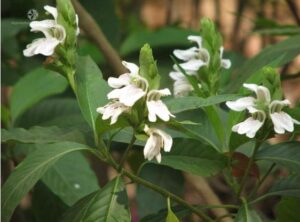Adathoda or Malabar nut is an immune booster. This herb is known for its antispasmodic, expectorant and blood-purifying qualities and used for a multitude of disorders including; leprosy, blood disorders, heart troubles, fever, vomiting, loss of memory, leucoderma, jaundice, tumors, mouth troubles, sore-eye, and gonorrhea.
The leaves, flowers, fruits and roots of adathoda are used to cure various diseases such as coughs, colds, asthma, skin infections, fever, bleeding piles and inflammation. Justicia adhatoda, commonly known in English as Malabar nut, adulsa, adhatoda, vasa, or vasaka, is a medicinal plant native to Asia, widely used in Indian systems of medicine.
Botanical name: Justicia adathoda
English name: Adathodai
Kannada name: Adusoge
Tamil name: Adathoda/vaasai


Active component:
Vasicine, an active component present in the adathoda is effective for inflammation caused by bacteria and other micro-organisms and reduces fever.
Chemical compounds:
The chemical compounds (Alkaloids) present in the adathoda leaf are used for treating the patient suffering from E-coli, typhoid and pneumonia.
Medicinal applications of Adathoda:
1. Healing power and curative properties: The leaves, roots and the flowers are extensively used in indigenous medicine as a remedy for cold, cough, bronchitis and asthma.
2. Bronchitis and Asthma:In acute stages of bronchitis it gives unfailing relief. Especially where the sputum is thick and sticky. It liquefies tilt sputum so that it is brought up more easily. For relief in asthma, the dried leaves should be smoked.
3. Tuberculosis : A preparation made from vasaka flowers, known as gulkand is used to treat tuberculosis. A few fresh petals of vasaka flowers should be bruised and put in a pot of clay. Some sugar crystals are added and the jar kept in the sun. It should be stirred every morning and evening. The preserve is ready for use in about a month.
Even the juice from its leaves is useful in treating tuberculosis. About 30 ml of the juice is taken thrice a day with honey. It relieves the irritable cough by its soothing action on the nerve and by liquefying the sputum, which makes expectoration easier.
4. Coughs: For coughs, 7 leaves of the plant are boiled in water, strained and mixed with 24 gms of honey. This decoction provides relief.
5. Intestinal worms: Its leaves, bark, the root, the fruit and flowers are useful in the removal of intestinal parasites. The decoction of its root and bark in doses of 30 gms twice or thrice a day for 3 days can be given for this purpose. The juice of its fresh leaves can also be used in doses of a tspn thrice a day for 3 days.
6. Skin diseases: A poultice of its leaves can be applied with beneficial results over fresh wounds, rheumatic joints and inflammatory swellings. A warm decoction of its leaves is useful in treating scabies and other skin diseases.
Home Remedies:
1. Preparations made using adathoda, along with thippili/hippali (piper longum), chukku (dry ginger), pepper, is commonly used in treating all conditions related to lungs, airway passage, throat etc. Of this adathoda herbs holds a vital position in treating asthmatic conditions- Cough, cold and asthma.
2. Adathodai leaves, chukku or dry ginger and pepper are taken. They are crushed and put in 1 litre of water and allowed to boil for 3-5 minutes. Then allow it to cool. When it reaches a lukewarm state, drink this 3 times a day for 3-4 days. This is found to be very useful in clearing cough, cold and phlegm in chest.
3. One of the other preparation for treating cough is to follow the above mentioned process using adathoda root and kandankathiri root. Piper longum powder is added to this decoction. This is taken three times a day after food.
4. In case of chronic wheeze, prepare a decoction using adathoda leaves, terminalia chebula (kadukkai) and grapes. Add honey and palm candy to this decoction and take it 3 times a day after food. Continue this till there is no wheezing.
5. Another combination is to prepare a decoction of adathoda root, kandankathiri root, dry ginger, horsegram and adding powder of allikizhangu (Nymphaea rubra) tuber. This is also effective in curing wheezing.
6. The juice obtained from the leaves can be used to treat bloody stool and mucus in stool.
7. The dry leaves can be rolled and smoked as a cigar to treat wheezing.
8. The flower of adathoda can be used to treat ailments of eye. For this the flowers are slightly shown on fire and then placed on the eyelids. Regular application is said to cure eye irritation and other minor ailments.
9. Adathoda vasica has also been used to speed delivery during childbirth.
10. Adathoda poultice also helpful in relieving rheumatic symptoms when applied to joints.
11. Adathoda tea/ kashayam is s a good expectorant when it is prepared with adhimadhuram (liquorice), thippili (piper longum) and thalisapathiri (Abies spectabilis). It is also good for patients suffering from asthma and bronchitis.


Dr Venkataramana Hegde & Dr.Nandhini V. Mohan
Veda wellness center
Nisarga Mane Sirsi
Uttarakannada District.
Ph: 9448729434 / 9597019032
Email : nisargamane6@gmail.com











